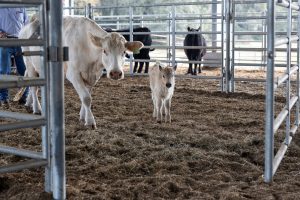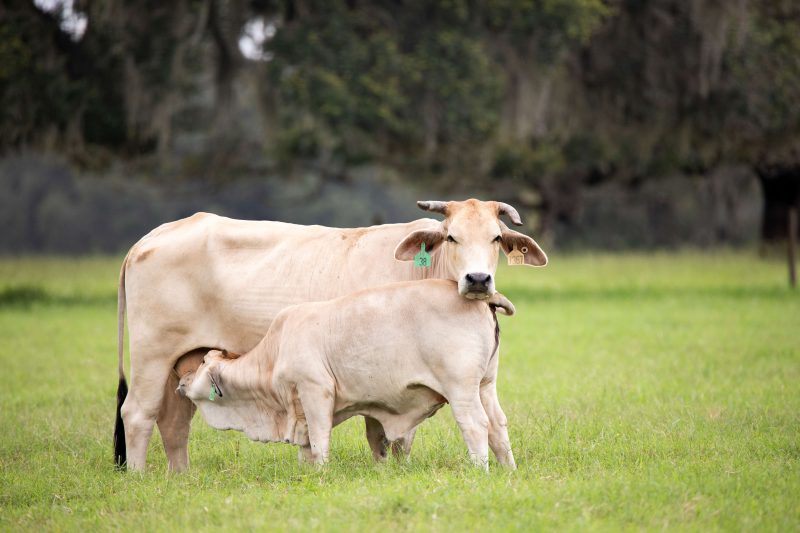In terms of beef cattle management, nutritional management is one of the largest costs a producer will accrue during the production cycle. Thus, having a good understanding of nutritional requirements and nutrient partitioning can play a major role in your bottom line. Energy demands of beef females vary considerably throughout the annual production cycle. It is crucial to manage cows such that their changing nutritional demands are met but expensive feed resources are not wasted. We will take a look at how the nutritional demands change over the course of the annual production cycle of brood cows.
–
Nutritional Prioritization
Once a female conceives, her body will do just about anything it can to maintain that pregnancy. A female’s basic metabolic function is the only thing that is more important than maintaining her pregnancy. However, when a female is in a negative state of energy (weight loss) or on a poor plane of nutrition, her body recognizes that she cannot support a pregnancy. Thus, reproductive function (not including pregnancy maintenance) will stop. This is why if a cow becomes thin (BSC 4 or less) she will no longer have a normal estrous cycle. From a survival standpoint, this makes perfect sense and from a management standpoint helps make it clear why cows in thin body condition do not breed back well.
–
Nutritional Requirements
Developing a nutritional strategy for your cow herd is facilitated by an understanding of the production cycle as well as the changing nutritional needs of your herd. In general, the production cycle of a beef female can be broken into 4 phases: 1. Pre-calving, 2. Postpartum, 3. Lactating & Pregnant, and 4. Gestation. When we break these phases apart, it’s clear to see that nutritional requirements vary from one to the next.
–
Pre-calving
This is the period roughly two months prior to calving it is one of the most crucial times in terms of having proper body condition. Females should maintain body condition scores (BCS) between 5 and 6. Females with optimum BCS have healthier calves and often breed back in timely manner. This is also the time where the fetus is growing at a rapid rate and placenta development is also increasing. As you approach the date of calving, you may notice a decrease in feed intake due to the increased size of the uterus in the body cavity, an area that is normally taken up by the rumen.
–
 Postpartum
Postpartum
This is the period within the first 70-90 days after calving. Nutritional demand is at its peak during this time due to many physiological changes within the cow’s body. She is now lactating, repairing a reproductive system, resuming a estrous cycle, and possibly still growing if it is a two-year old cow. Usually, voluntary feed intake increases during this time to help with meeting her nutritional demands. When a mature cow enters calving and lactation, her protein and energy requirements increase. A lactating cow at peak lactation (60–80 days postpartum) has an energy demand of 15–16 lbs. of total digestible nutrients (TDN) per day. There is a shift in the cow’s first limiting nutrient from protein to energy. (Bremer, M., UNL)
–
Lactating & Pregnant
The next phase of the production cycle takes place over a period of a couple of months. This assumes that adequate body condition and reproductive systems are working properly and that she was successfully bred back. This is the time of peak lactation, but generally, the lactation production starts decreasing later in this phase. The limited fetal growth during this time does not necessarily increase the nutritional demand but we often see cattle drop weight and body condition during this time.
–
Gestation
This is the time after previous calves are weaned and lasts approximately 100-110 days. This is the point of lowest nutritional requirement, mainly because lactation has ended and fetal growth is still fairly slow. This is the best time to put weight back on your cows and achieve the BCS of 5-6 as discussed earlier. Activity and voluntary feed intake is usually lowest at this point.
–

If you meet the nutritional needs of the cow at each stage of production, she can stay in good flesh, breed soon after calving, wean heavy calves, and maintain her body systems. Credit: UF/IFAS Photo archive
Summary
You have likely heard the phrase, “You can starve the profit out of a cow.” The point is that trying to save money at the wrong time, by keeping feed costs low, may actually be hurting their annual production. Supplemental feed, hay, and pasture fertilizer are very expensive, but if your cow’s nutritional needs are not met, her body will shut down systems to protect her maintenance requirements. As she losses more and more weight, it will take longer to recover, especially when grazing unfertilized bahiagrass. Certainly you can waste money over fattening cattle, but much more often cattle get thin and stop cycling delaying breeding until conditions improve. Knowing the nutrient requirements at various ages and stages of production can help ensure optimal production when you match the forage and feeds to fit what the cow needs to keep all of body systems operating at an optimum level. Contact your County Extension Agent for assistance in developing a annual nutrition program for your herd. They work closely with state specialists that can provide science-based recommendations for managing pastures, hay production, supplemental nutrition, and reproduction. The goal is to produce a healthy calf every year, while also priming the cow’s systems for future success year after year. With targeted supplementation and quality forages, it is much easier to balance cost and production objectives.
–
Additional information:
–
Supplementation Needs for Gestating and Lactating Beef Cows and Comparing the Prices of Supplement Sources
–
Meeting the Cows’ Nutritional Needs After Calving
- Hay Quality and Quantity Considerations for Winter Feeding - September 5, 2025
- Managing Lice on Cattle - February 28, 2025
- Nutritional Demands of Beef Females Through Various Production Stages - September 6, 2024
